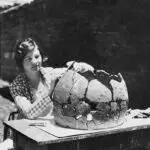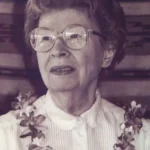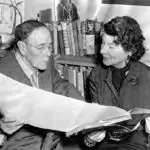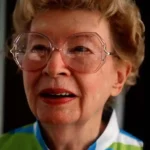Laura Maud Thompson
Table of Contents
Share This
Study of CHamoru culture
Laura Maud Thompson (1905 – 2000), a distinguished sociocultural anthropologist who studied peoples and cultures around the world, is best known for her comprehensive studies of the CHamoru/Chamorro people of Guam. If indeed the CHamorus of Guam constitute a matrilineal society, then, by virtue of her long-term affiliation with Guam and profound affinity for the CHamoru people, Thompson may be regarded as perhaps Guam’s most significant intellectual mater. Her best known book, Guam and Its People published in 1941, 1947, and 1969, is a singular testament to her admiration and empathy for the CHamorus of Guam.
Thompson was born in Honolulu, Hawaiʻi, on 23 January 1905. In her comprehensive autobiography, Beyond The Dream: A Search For Meaning, Thompson wrote that she possessed a very strong social consciousness by the age of 10 and knew that she must devote her life to “helping people.”
After graduating from Punahou School in Hawaiʻi, Thompson received her BA from Mills College, her PhD in anthropology from the University of California, Berkeley, and later an honorary LLD from Mills College. She also undertook graduate studies at Radcliffe. She taught at the University of North Carolina, North Carolina State College, City College and Brooklyn College of CUNY, Southern Illinois University, San Francisco State University, and the University of Hawaiʻi. Thompson was the 1979 recipient of the Bronislaw Malinowski Award from the Society for Applied Anthropology.
The late Dr. Leonard Mason of Honolulu summarized Thompson’s pre-World War II Guam experiences as follows:
…[in 1938] she accepted an offer from the US naval governor of Guam…to serve as his consultant on native affairs. Her Guam assignment was a six-month field study of the native Chamorro population, their daily life, land use customs, changing economy, schooling, cultural values, and local government under American military rule since 1899, when Guam was ceded to the United States after the Spanish-American War. Her observations were intended to help the Naval Administration better understand the problems faced by the Chamorro community.
Did field work in Malesso'
Thompson was stationed in Hagåtña, Guam’s capital, but she soon set up field headquarters in Malesso’/Merizo, a village at the island’s southern end. There she was assisted by two helpful CHamoru men in learning the language and initiating contact with local families. She had fruitful discussions with the naval governor and his staff as her work progressed.
In October 1938, the Guam Recorder heralded Thompson’s arrival on Guam, noting that Thompson had arrived on the Chaumont on 18 October to begin research studies in applied anthropology. This endeavor was sponsored jointly by the University of Hawaiʻi, the Institute of Pacific Relations, and the naval government.
What Thompson learned during her field research in Guam has withstood the test of time. Her in-depth knowledge of CHamoru culture and society, gathered while using the classic field methodology of anthropology, i.e., participant-observation, is lively and penetrating. Her published works about Guam have been studied and admired up to the present day. In the process, Thompson gained lifelong friendships on Guam and a personal mission of being an advocate for the CHamoru people.
Denied permission to return after WWII
Having conducted her field studies in Guam before the beginning of World War II, Thompson was denied permission to return to Guam for many years thereafter. This was principally because of her lobbying endeavors in Washington DC on behalf of the people of Guam, especially with reference to their political autonomy. Thompson was actively involved with the Institute of Ethnic Affairs in testifying before numerous US congressional committees. The eventual outcome was a change in Guam’s status, from a dependency to an Unincorporated Territory, when the Guam Organic Act was passed by US Congress in 1950. No longer “nationals,” the people of Guam were at last granted US citizenship.
On her first return visit to Guam in 1977, Thompson was invited to be the keynote speaker for the CHamoru Studies Conference held at George Washington High School in Mangilao. Thompson visited Guam again in April 1987, as the University of Guam’s Annual College of Arts and Sciences Research Conference keynote speaker. Her erudite presentation on that occasion, entitled “Talking Stones,” appears in print and can also be viewed via videotape at the University of Guam Library.
On 27 November 1991, a reception was held at the Bernice P. Bishop Museum in Honolulu to honor Thompson on the publication of her book, Beyond the Dream. The event was hosted by the Richard F. Taitano Micronesian Area Research Center (MARC) of the University of Guam. In 1929, as an assistant ethnologist at Bishop Museum, Thompson spent six months studying the Hans Hornbostel archaeological collection from Guam and the Northern Mariana Islands. A second reception in honor of her new book, again hosted by MARC, was held at the Gallery of the Council for the Arts and Humanities (CAHA) on Guam on 11 December 1991.
After Thompson died at the age of 98, a memorial service was held in her honor in Honolulu on 29 January 2000. Among those present was her longtime friend Jesse S. Perez of Guam. A younger Jesse appears with a younger Thompson on the cover of Beyond The Dream. The photo was taken in 1937 at the site of the old Spanish church in Humåtak. Jesse, then seventeen, was a research assistant for Thompson during her original Guam field study.
Also present for Thompson’s Memorial Service was Rosanna P. Barcinas of Guam, a granddaughter of Jesus C. Barcinas, who wrote the “Merizo Diary” which appears as an appendix in the 1947 revised version of Guam and Its People. Jesus Barcinas and Thompson shared a joyful reunion at the University of Guam in 1987. A photo of Thompson meeting her friend, Guam educator Rosa Aguigui Reyes in 1987, who was her primary female research assistant 50 years earlier during Thompson’s field study in Malesso’ in 1937, appears in Beyond The Dream.
A memorial service was also held in Malesso’ on 11 February 2000, for Thompson at the Malesso Martyrs Memorial School. The Mass in her memory was officiated by Father Mike Crisostomo, under the leadership of then-Malesso’ Mayor Ignacio “Buck” Cruz.
CHamoru scholar Dr. Lilli Perez-Iyechad’s 1998 doctoral dissertation for Bryn Mawr College is essentially a re-study of some of the themes apparent in Thompson’s Guam and Its People. Perez-Iyechad’s dissertation was later published as An Historical Perspective of Helping Practices Associated With Birth, Marriage and Death Among Chamorros in Guam in 2001.
A session titled, “Remembering Laura Thompson” was held at the University of Guam’s College of Arts and Sciences Annual Research Conference on 27 April 2000 to explore Thompson’s life and work.
Married three times, Thompson is survived by two nieces, a nephew, and a granddaughter and other relatives by marriage. Although she studied peoples and cultures in wide-ranging geographic locations, her heart and soul seem to belong to the people of Guam.
She was also the author of nine books and more than 70 articles published in professional journals. Her book, The Secret of Culture: Nine Community Studies, contains a perceptive chapter concerning the CHamoru people and culture of Guam. Some of her unpublished papers are housed in the Richard Flores Taitano Micronesian Area Research Center at the University of Guam, including a set of Guam children’s drawings. The official depository for her academic writings is the Smithsonian Institution in Washington DC. The literary executrix of her academic materials is Dr. Rebecca A. Stephenson.
The opening paragraph of the lengthy tribute to Thompson in the Congressional Record, US House of Representatives, Washington, DC (filed on 8 February 2000) begins:
For the people of Guam and for researchers everywhere, [Thompson’s book] Guam and Its People is the seminal work on the essence of Chamorro culture. She was the first anthropologist to formally study the culture of the people of Guam, and every student, researcher or any person interested in serious thinking about Guam must begin by reading and understanding her work.
Thompson was awarded posthumously the Ancient Order of the Chamorri on Guam in recognition of her profound contributions to Guam and its people.
For further reading
Citizenship, an Organic Act, and Civilian Administration for the People of Guam. HR. 80th Cong., 1st sess., Congressional Record 93, pt. 11: A2568-A2570.
Iyechad, Lilli Perez. An Historical Perspective of Helping Practices Associated with Birth, Marriage and Death Among Chamorros in Guam. Lewiston: Edwin Mellen Press, 2001.
Parezo, Nancy J., and Rebecca A. Stephenson. “Laura Maud Thompson (1905-2000).” American Anthropologist 103, no. 2 (June 2001): 510-514.
Thompson, Laura M. Beyond The Dream: A Search for Meaning. Mangilao: Richard F. Taitano Micronesian Area Research Center, University of Guam, 1991.
–––. Guam and Its People. With a Village Journal by Jesus C. Barcinas. 3rd ed. New Jersey: Princeton University Press, 1947.
–––.“Talking Stones.” Glimpses of Guam and Micronesia 27, no. 4 (December 1987): 16-21.
–––. The Secret of Culture: Nine Community Studies. New York: Random House, 1969.




